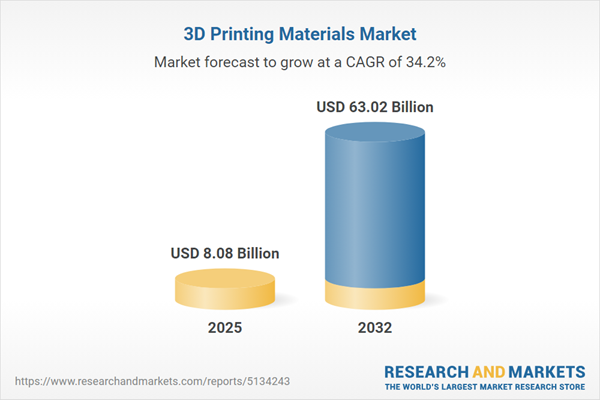Speak directly to the analyst to clarify any post sales queries you may have.
The 3D printing materials market is redefining how enterprises approach manufacturing and product development. By leveraging material innovation and additive manufacturing, organizations are achieving greater operational flexibility and enabling diverse applications across major industries.
Market Snapshot: 3D Printing Materials Market Trends and Growth
The 3D printing materials market has experienced robust growth, supported by continuous improvements in materials science and digital process integration. Enterprises in verticals such as manufacturing, healthcare, and engineering are rapidly advancing their design capabilities and production efficiencies through the adoption of additive manufacturing. These advancements are fueled by the need for accelerated product development cycles, greater design freedom, and improved durability of finished goods. The shift toward digital transformation and the strengthening of supply chain resilience are further intensifying the demand for versatile 3D printing material options. As organizations strive to meet evolving customer expectations and address regulatory and supply chain shifts, strategic investment in advanced materials has become a top priority for decision-makers.
Scope & Segmentation: 3D Printing Materials Market
- Material Composition: Encompasses ceramics, composites, and engineered metals, including aluminum, titanium, and stainless steel. These materials support high durability and precision, serving industries with rigorous reliability requirements such as automotive and aerospace.
- Photopolymers: Acrylate and epoxy-based photopolymers enable efficient rapid prototyping. Their fast-curing properties facilitate design adjustments and decrease time-to-market for emerging products.
- Thermoplastics: Sought after for compliance and lifespan, thermoplastics are utilized in industrial and consumer settings to achieve reliable, repeat-use performance in a variety of applications.
- Material Form: Available as filaments, pellets, powders, and resins, these versatile forms allow manufacturers to cover every stage from concept prototyping to large-scale production and cater to diverse process requirements.
- Material Grade: Offered in sector-specific dental and industrial grades, these materials meet strict standards of reliability and performance, crucial in healthcare and aerospace applications.
- End Use Industry: Widely employed in aerospace, defense, healthcare, manufacturing, automotive, consumer, and education sectors for both finished components and driving ongoing product innovation.
- Application: Deployed across aerospace components, medical devices, manufacturing aids, and prototype development to enhance lifecycle management and streamline product introduction.
- Regions: Coverage spans North America, Europe, Asia-Pacific, and Middle East & Africa. Each region presents unique regulatory dynamics, technology adoption rates, and supply chain characteristics influencing market expansion.
- Companies Profiled: Leading participants include BASF SE, Arkema S.A., Evonik Industries AG, Covestro AG, Henkel AG & Co. KGaA, Koninklijke DSM N.V., Saudi Basic Industries Corporation, Stratasys Ltd., 3D Systems Corporation, and HP Inc., all noted for robust R&D investment and adaptive market strategies.
Key Takeaways for Senior Decision-Makers
- Composites and engineered metals are raising standards for product durability and precision, which is essential in regulated sectors where reliability is paramount.
- Increased focus on material traceability within supply chains is helping organizations support sustainability goals and lessen the risk of procurement interruptions.
- Digital transformation, including the integration of artificial intelligence and process automation, is enhancing production oversight and operational efficiency in additive manufacturing environments.
- The adoption of flexible procurement models is enabling businesses to better manage evolving regulatory conditions and improve organizational resilience.
- Strategic engagement between manufacturers, technology providers, and research entities is supporting faster market adoption of advanced materials and expanding their presence in highly regulated fields.
Tariff Impact on Global Trade and Supply Chains
Recent tariff changes in the United States have introduced added complexity to global procurement processes for 3D printing materials. Companies are adapting by reassessing supplier strategies, strengthening risk management frameworks, and diversifying sourcing to ensure production continuity. Leadership teams are prioritizing methods to safeguard supply chain integrity in the face of fluctuating trade conditions.
Methodology & Data Sources
The findings in this research are grounded in rigorous methodology, drawing from technical literature, analysis of recent patents, and direct industry expertise spanning commercial, procurement, and technical roles. This comprehensive approach ensures that insights are practical and actionable for executive decision-making.
Why This Report Matters for Market Leaders
- Highlights how advances in materials science and a regionally tailored approach empower leadership teams to act confidently and capitalize on growth opportunities in additive manufacturing.
- Enables executives to bolster supply chain resilience, pinpoint potential operational risks, and investigate partnership avenues for steady market development.
- Facilitates benchmarking and helps organizations utilize additive manufacturing and innovative materials to achieve goals in an increasingly competitive landscape.
Conclusion
The 3D printing materials market is evolving rapidly, demanding operational flexibility and sustained material innovation. Executives will find actionable guidance here to manage increased complexity and foster enduring business growth.
Additional Product Information:
- Purchase of this report includes 1 year online access with quarterly updates.
- This report can be updated on request. Please contact our Customer Experience team using the Ask a Question widget on our website.
Table of Contents
3. Executive Summary
4. Market Overview
7. Cumulative Impact of Artificial Intelligence 2025
Companies Mentioned
The companies profiled in this 3D Printing Materials market report include:- BASF SE
- Arkema S.A.
- Evonik Industries AG
- Covestro AG
- Henkel AG & Co. KGaA
- Koninklijke DSM N.V.
- Saudi Basic Industries Corporation
- Stratasys Ltd.
- 3D Systems Corporation
- HP Inc.
Table Information
| Report Attribute | Details |
|---|---|
| No. of Pages | 182 |
| Published | November 2025 |
| Forecast Period | 2025 - 2032 |
| Estimated Market Value ( USD | $ 8.08 Billion |
| Forecasted Market Value ( USD | $ 63.02 Billion |
| Compound Annual Growth Rate | 34.2% |
| Regions Covered | Global |
| No. of Companies Mentioned | 11 |









